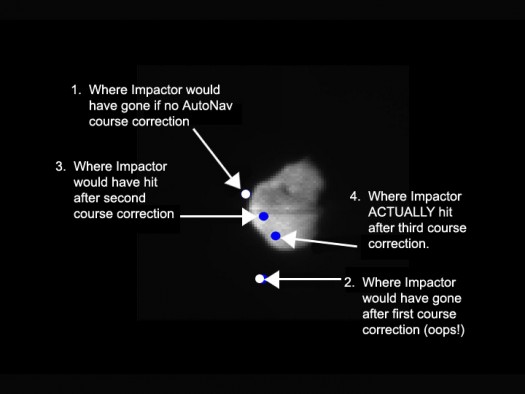Improbable Bulls-Eye
September 2005By by Dr. Tony Phillips
by Dr. Tony Phillips;The ship glides deeper into the cloud and jettisons its cargo, the “impactor.” Bulls-eye! A blinding flash, a perfect strike.
>> Macro menumgr_macro_spaceplaceimage not found <<
As incredible as it sounds, this really happened on the 4th of July, 2005. Gliding through the vast atmosphere of Comet Tempel 1, NASA’s Deep Impact spacecraft pinpointed the comet’s 3x7-mile wide nucleus and hit it with an 820-lb copper impactor. The resulting explosion gave scientists their first look beneath the crust of a comet.
That’s navigation.
Credit the JPL navigation team. By sending commands from Earth, they guided Deep Impact within sight of the comet’s core. But even greater precision would be needed to strike the comet’s spinning, oddly-shaped nucleus.
On July 3rd, a day before the strike, Deep Impact released the impactor. No dumb hunk of metal, the impactor was a spaceship in its own right, with its own camera, thrusters and computer brain. Most important of all, it had “AutoNav.”
AutoNav, short for Autonomous Navigation, is a computer program full of artificial intelligence. It uses a camera to see and thrusters to steer—no humans required. Keeping its “eye” on the target, AutoNav guided the impactor directly into the nucleus.
The system was developed and tested on another “Deep” spacecraft: Deep Space 1, which flew to asteroid Braille in 1999 and Comet Borrelly in 2001. The mission of Deep Space 1 was to try out a dozen new technologies, among them an ion propulsion drive, advanced solar panels and AutoNav. AutoNav worked so well it was eventually installed on Deep Impact.
“Without AutoNav, the impactor would have completely missed the nucleus,” says JPL’s Ed Riedel, who led the development of AutoNav on Deep Space 1 and helped colleague Dan Kubitschek implement it on Deep Impact.
En route to the nucleus, AutoNav “executed three maneuvers to keep the impactor on course: 90, 35, and 12.5 minutes before impact,” says Riedel. The nearest human navigators were 14 light-minutes away (round trip) on Earth, too far and too slow to make those critical last-minute changes.
Having proved itself with comets, AutoNav is ready for new challenges: moons, planets, asteroids … wherever NASA needs an improbable bulls-eye.
Dr. Marc Rayman, project manager for Deep Space 1, describes the validation performance of AutoNav in his mission log at http://nmp.nasa.gov/ds1/arch/mrlog13.html (also check mrlog24.html and the two following). Also, for junior astronomers, the Deep Impact mission is described at http://spaceplace.nasa.gov/en/kids/deepimpact/deepimpact.shtml

Comet Tempel 1, as seen by the Deep Impact impactor’s camera. Three last-minute AutoNav-controlled impact correction maneuvers enabled the Impactor to hit the bulls-eye.
This article was provided by the Jet Propulsion Laboratory, California Institute of Technology, under a contract with the National Aeronautics and Space Administration.



